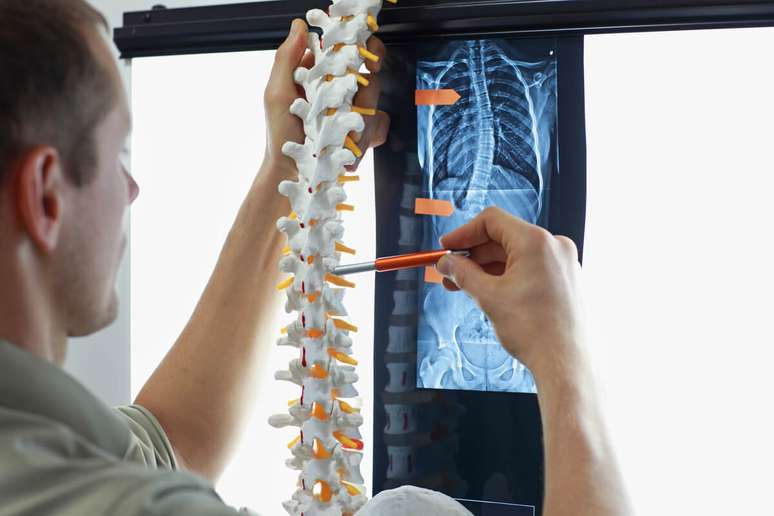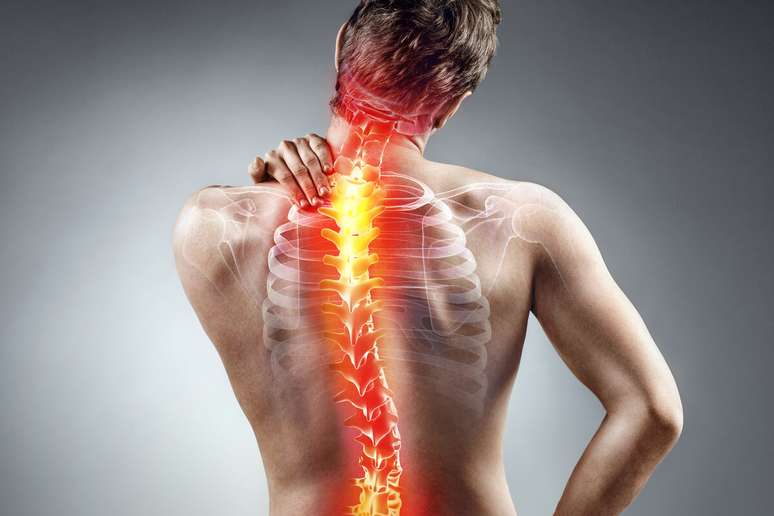Spine disease is quite common and mostly affects women.
Scoliosis is a disease characterized by the deviation of the spine to the right or left, resulting in an “S” or “C” shape. “It is a deformity of the spine in the three planes of space, that is, it consists of a lateral curvature of the spine with a rotation of the vertebrae within the curve”, explains Patrícia Italo Mentges, physiotherapist specializing in the treatment of scoliosis.
html[data-range=”xlarge”] figure image img.img-e35d161a6658b085a97bc5aabc1d4304lt94c6fv { width: 774px; height: 516px; }HTML[data-range=”large”] figure image img.img-e35d161a6658b085a97bc5aabc1d4304lt94c6fv { width: 548px; height: 365px; }HTML[data-range=”small”] figure image img.img-e35d161a6658b085a97bc5aabc1d4304lt94c6fv, html[data-range=”medium”] figure image img.img-e35d161a6658b085a97bc5aabc1d4304lt94c6fv { width: 564px; height: 376px; }
Scoliosis and bad posture
It’s important to know that scoliosis that involves spinal rotation, called structural scoliosis, doesn’t develop from wrong postures, says the physiotherapist. However, it is difficult to define the origin of this problem but it is known that it is due to a malformation of the cartilages and that it occurs more frequently in girls.
Patricia Italo Mentges also points out that scoliosis should not be confused with poor posture. “It’s a disease and should be treated as such,” she reveals. On the other hand, a small lateral deviation can be the result of poor postural habits.
origin of scoliosis
There are some scoliosis who have a definite cause, such as those resulting from cerebral palsy and others like it, with a neurological background; those caused by malformations, poliomyelitis, muscular dystrophies, among others. Scoliosis that does not have a well-defined origin are called idiopathic scoliosis and are usually linked to genetic factors.
degrees of scoliosis
According to the World Health Organization (WHO), 2 to 4% of the population has scoliosis, that is, it is a relatively common disease. But there are different degrees, which can take years for the person to discover that they have the disease, in the case of a mild degree.
These grades are divided into mild, moderate and severe scoliosis. These denominations determine degrees that can be measured in specific radiographic examinations requested by the doctor, as Patricia Italo Mentges explains. So that the diversion column to be considered a scoliosis, it must have at least 10 degrees.
Influences in daily life
Not all grades of scoliosis impair people’s daily activities. “Mild to moderate scoliosis tends not to impact so directly on the routine of life, unless they are accompanied by other disorders, such as neurological ones,” emphasizes the physiotherapist.
Also, the most common scoliosis, adolescent idiopathic scoliosis, allows you to do this exercises. Already the most severe cases of scoliosis, with higher degrees, directly affect daily activities. This is because these cases “affect breathing, require some rest and avoid strenuous activities,” adds Patrícia Italo Mentges.

Importance of disease diagnosis
The diagnosis of scoliosis is made by clinical tests and radiography (X-rays). The disease can be diagnosed in newborns (still in the first year of life), infantile (up to three years of age) and juvenile (from 4 years to adolescence). Idiopathic scoliosis, the worst form of the disease, is linked to genetic factors and is the most widespread, reaching 85% of cases and affecting girls in 80% of cases.
It is very important that scoliosis is identified as early as possible, as there is a better chance of successful treatment. Your scoliosis physical therapist insists that any irregularities are checked with your pediatrician, orthopaedist, or physical therapist as soon as possible. “Don’t leave it for later, because scoliosis has a period where it’s perfectly treatable. If we leave it for later, the chances of a good treatment decrease dramatically,” she says.
scoliosis treatment
Treatment of adolescent scoliosis depends on the patient’s age, degree of bone maturation (seen on x-ray), time since first menstruation (in girls), and degree and type of curvature seen on x-ray. Generally patients with curves between 10 and 20 degrees are treated with physical activity, muscle strengthening and physiotherapy, with exercises and stretching.
Follow-up is important to observe the evolution of the curve, i.e. to see if there is a worsening of the scoliosis. Adolescent patients with curves between 20 and 40 degrees can be treated with a brace, depending on age, bone maturation, and time since first menstruation.
Source: Terra
Ben Stock is a lifestyle journalist and author at Gossipify. He writes about topics such as health, wellness, travel, food and home decor. He provides practical advice and inspiration to improve well-being, keeps readers up to date with latest lifestyle news and trends, known for his engaging writing style, in-depth analysis and unique perspectives.








![Un Si Grand Soleil Preview: Eliot Between Life and Death!… What’s in store for the week of October 20-24, 2025 [SPOILERS] Un Si Grand Soleil Preview: Eliot Between Life and Death!… What’s in store for the week of October 20-24, 2025 [SPOILERS]](https://fr.web.img4.acsta.net/img/f1/c4/f1c410b63f2bfb1cd2353db8bf7e9d58.jpg)
